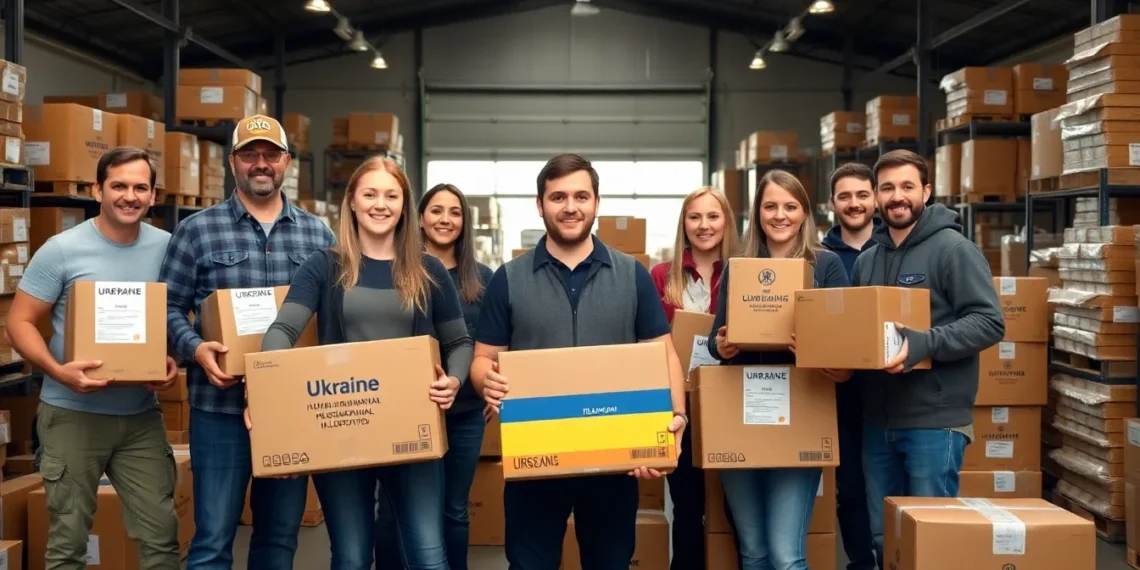In a world where geopolitical tensions can feel as chaotic as a cat in a room full of laser pointers, understanding the total aid to Ukraine by country is crucial. As nations rally to support Ukraine, the numbers tell a compelling story of solidarity, strategy, and sometimes, a bit of friendly competition. Who knew that helping a country could turn into a global leaderboard?
From military support to humanitarian efforts, the contributions vary widely, showcasing each nation’s priorities and resources. This article dives into the nitty-gritty of aid distribution, revealing not just the dollar amounts but the motivations behind them. So grab your favorite beverage and prepare to be informed and entertained as we explore the fascinating world of international aid to Ukraine.
Overview of Total Aid to Ukraine by Country
Total aid to Ukraine varies significantly by country, reflecting each nation’s strategic priorities and commitments. The United States leads in contributions, providing over $60 billion in military, economic, and humanitarian assistance. European nations also play a critical role. Germany allocated $16 billion, focusing on military support and energy assistance.
Other key contributors include the United Kingdom, which delivered approximately $5 billion, primarily in weapons and military gear. Canada and Poland’s aid amounts to around $1 billion each, providing significant support in humanitarian efforts and military supplies. Japan, traditionally non-military in its aid approach, pledged about $600 million, emphasizing humanitarian assistance.
Australia joined the effort with $400 million, mostly directed towards military aid. Smaller nations, including Sweden and the Netherlands, also made notable contributions, mainly in terms of military supplies and financial aid. Each country’s support reflects its political stance and capacity to assist Ukraine during this crisis.
Aid packages encompass diverse forms, including direct financial aid, military equipment, and humanitarian supplies. Countries like Norway and Denmark focus on versatile support, balancing military and humanitarian needs. The overall landscape of contributions demonstrates a united front among allies as they respond to Ukraine’s challenges.
Tracking these contributions aids in understanding international relations and the commitment to Ukraine’s sovereignty. The competitive nature of aid highlights not only the geopolitical interests but also the humanitarian empathy driving these nations to stand in solidarity with Ukraine.
Key Contributing Countries
Multiple nations have stepped up to support Ukraine through significant financial and military aid. Among these, the United States stands out as the leading contributor.
United States Aid Contributions
The United States has provided over $60 billion in assistance, combining military, economic, and humanitarian support. This expansive contribution reflects US strategic interests in bolstering Ukraine against aggression. Military equipment, training, and financial aid form the core of this assistance. Beyond military efforts, humanitarian aid, including food and medical supplies, demonstrates a comprehensive approach to Ukraine’s needs. Such robust support aims to reinforce Ukraine’s sovereignty and stability.
European Union Support
European Union member states collectively contribute substantial aid, marking a unified response to Ukraine’s challenges. Germany leads the EU with approximately $16 billion, predominantly for military support. The United Kingdom follows closely, offering around $5 billion, focusing on arms and humanitarian assistance. Other EU countries, like Poland and Sweden, join the effort, contributing about $1 billion each. Norway and Denmark balance their aid packages, combining military assistance with humanitarian efforts, showcasing a multifaceted approach.
Other Major Donor Nations
Canada and Japan also play crucial roles in providing aid to Ukraine. Each nation has pledged around $1 billion, with Japan focusing on humanitarian efforts amounting to $600 million. Australia contributes approximately $400 million, primarily directed toward military assistance. Smaller nations like the Netherlands and Finland also make noteworthy contributions. Their collective efforts highlight a global coalition dedicated to supporting Ukraine in its time of need.
Types of Aid Provided
Countries have delivered various forms of aid to Ukraine, significantly impacting its ongoing efforts. The primary categories include military assistance, humanitarian aid, and financial support.
Military Assistance
Military assistance represents a substantial aspect of aid. The United States has led in this area, contributing over $60 billion with a focus on providing advanced military equipment and training. European nations follow closely, with Germany supplying around $16 billion in military support and the United Kingdom offering approximately $5 billion. Other contributors like Canada and Poland have each provided around $1 billion aimed at enhancing Ukraine’s defense capabilities. Japan and Australia also joined military endeavors by pledging hundreds of millions, highlighting a collective commitment to strengthening Ukraine’s military resilience.
Humanitarian Aid
Humanitarian aid remains crucial amid the ongoing crisis in Ukraine. Various countries have stepped up to provide essential support. For instance, Japan committed about $600 million, focusing mainly on humanitarian relief. Countries such as Norway and Denmark have balanced their contributions by allocating significant portions toward aid supplies, addressing urgent needs like food and medical assistance. Numerous smaller nations, including Sweden, the Netherlands, and Finland, have also made notable contributions to humanitarian efforts. This wide-ranging support illustrates the international community’s commitment to alleviating suffering in Ukraine.
Financial Support
Financial support plays a vital role in stabilizing Ukraine’s economy during challenging times. Governments worldwide have extended direct financial aid to bolster Ukraine’s infrastructure and services. The United States has been a frontrunner, providing significant financial resources alongside military assistance. The United Kingdom followed, contributing substantial financial aid as part of its broader support package. Other contributors such as Canada and Australia also pledged millions to strengthen Ukraine’s fiscal capacity. This financial assistance reflects a shared understanding of the economic challenges Ukraine faces amidst ongoing conflict and unrest.
Impact of Aid on Ukraine
Aid has substantially bolstered Ukraine’s defense capabilities since the onset of conflict. The U.S. contribution of over $60 billion has positioned Ukraine to counter threats effectively. Military support from European nations like Germany and the United Kingdom, amounting to $16 billion and $5 billion respectively, has also been significant in strengthening military readiness.
Humanitarian efforts play an essential role alongside military assistance. Various countries, including Canada and Japan, focus on urgent humanitarian needs, with Japan pledging about $600 million primarily for aid. Food, medical supplies, and shelter remain critical as millions face displacement and hardship.
Economic aid stabilizes Ukraine’s economy amid ongoing operations. Countries like the U.S., U.K., Canada, and Australia prioritize investments in infrastructure and services. This financial backing enhances resilience against external pressures and supports daily life for Ukrainian citizens.
Geopolitical interests align with humanitarian empathy in these aid efforts. The combination of military assistance and humanitarian support underscores a comprehensive approach to Ukraine’s needs. Allies forge stronger bonds through these contributions, reinforcing commitments to sovereignty and security.
Notably, smaller contributions from nations like Sweden, the Netherlands, and Finland highlight the global solidarity toward Ukraine. Each country’s engagement reflects a shared sense of responsibility, contributing to a united front against aggression.
The impact of aid on Ukraine showcases a multidimensional response to crisis conditions. The ongoing assistance from diverse nations illustrates a collective determination to support Ukraine’s sovereignty, bolstering military, humanitarian, and economic needs.
Future Prospects for Aid
Future aid to Ukraine depends on various geopolitical factors. Continued military support is likely necessary to counter any ongoing threats. Countries involved show strong commitments; however, the dynamics could shift based on international pressures. The United States remains a cornerstone, having contributed over $60 billion, and future allocations may increase as the situation evolves.
European nations also aim to deepen their involvement. The U.K. and Germany will likely continue leading with significant military assistance. Japan, with its pledge of about $600 million, may expand its focus to include more infrastructural support. Contributions from countries like Canada and Poland might grow as global politics dictate a need for sustained aid.
Humanitarian assistance remains critical. Nations must address pressing needs such as food, medical supplies, and shelter for displaced individuals. Support from Australia and Scandinavian countries has proven impactful, suggesting that future aid packages could mirror these efforts. Humanitarian priorities are likely to stay at the forefront as conflicts persist.
Economic aid plays a pivotal role in stabilizing Ukraine’s economy. Strategies may incorporate investments aimed at enhancing resilience against external pressures. Ongoing evaluations of the effectiveness of these funds will influence future contributions.
Countries might form new coalitions to maximize impact. Collaboration between nations can strengthen Ukraine’s defense capabilities while fostering a united commitment to sovereignty. Overall, the future of aid hinges on global political landscapes, humanitarian needs, and economic stabilization efforts.
A Collective Commitment to Its Sovereignty and Stability
The ongoing support for Ukraine from various nations underscores a collective commitment to its sovereignty and stability. This diverse aid landscape reveals not just military assistance but also vital humanitarian and economic support. Countries are responding to urgent needs while navigating complex geopolitical interests.
As the situation evolves, the dynamics of aid may shift, yet the united front among allies remains a powerful testament to international solidarity. The future of aid will likely adapt to emerging challenges, emphasizing the importance of continued collaboration to ensure Ukraine’s resilience and security.







